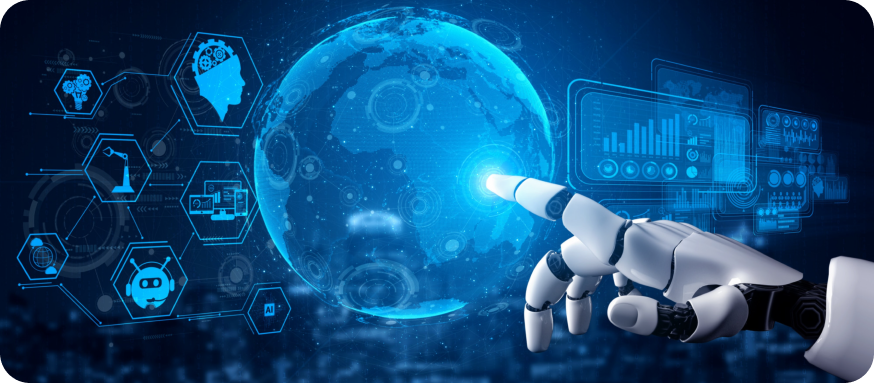Automation and Human Touch in B2B Lead Generation
I start every blog post with a lingering question: is it worth it? Would it give any value? Today is the same, while I write about Automation and Human touch in B2B Lead Generation.
We`re definitely in an era of automation, especially nowadays when AI tools are widespread and being used for numerous purposes. In that environment, when we discuss if AI will take our jobs and how things might shift dramatically, talking about Human Verification in the Data realm really sounds like beating the dead horse.
As I`m working in the company that prides itself with the fact that every lead we gather is human verified, I`ve started worrying if we`re fighting the lost cause and if we`re dinosaurs in an age of hovercrafts and spaceships. Therefore, I have opened my OpenAI ChatGPT 3.5 (Free version) and asked AI to compare automated and human-verified lead generation:
Automated Lead Generation:
Pros:
- Scalability: Automated systems can handle a large volume of leads efficiently without much manual intervention.
- Cost-Effectiveness: Automated processes often require lower upfront investment compared to hiring human resources.
- Speed: Automated systems can generate leads quickly, allowing for faster response times and potentially higher conversion rates.
- Consistency: Automation ensures a standardized approach to lead generation, reducing the likelihood of human error.
Cons:
- Lack of Personalization: Automated systems may struggle to provide the level of personalization and customization that human interaction can offer.
- Limited Contextual Understanding: Algorithms may not always interpret nuanced data accurately, leading to potential mismatches or missed opportunities.
- Difficulty in Handling Complex Scenarios: Automated systems may struggle with complex lead qualification criteria or scenarios that require human judgment.
Competitive Advantages:
- Competitive advantage in industries where speed and volume are paramount.
- Ideal for businesses targeting broad audiences with relatively simple lead qualification criteria.
- Can leverage data analytics and machine learning for continuous optimization and improvement.

Human-Verified Lead Generation:
Pros:
- High-Quality Leads: Human verification can ensure that leads meet specific criteria and are more likely to be genuinely interested in the product or service.
- Personalized Approach: Human interaction allows for personalized communication, which can enhance the customer experience and build trust.
- Adaptability: Humans can adapt to changing circumstances or unexpected situations more effectively than automated systems.
- Understanding Nuances: Humans can understand and interpret contextual nuances, which may be crucial for successful lead generation in certain industries or markets.
Cons:
- Resource Intensive: Human-verified lead generation can be more time-consuming and labor-intensive, requiring dedicated personnel.
- Subjectivity: Human judgment can introduce bias or inconsistency in the lead verification process.
- Higher Costs: Human resources typically come with higher costs compared to automated solutions.
- Limited Scalability: Human-verified processes may struggle to scale efficiently, especially when dealing with large volumes of leads.
Competitive Advantages:
- Competitive advantage in industries where personalization and relationship-building are critical.
- Particularly effective for businesses operating in niche markets with specific target demographics.
- Ability to provide tailored solutions and address complex customer needs effectively.

Based on this breakdown, it became obvious that automation is far superior when it comes to speed, scalability and cost-effectiveness. And that the competitive advantage revolves around the relatively simple use cases, broad audiences and high expected output.
Then, I started thinking about those use cases that would fit the criteria described above. Which are those companies where the world is their oyster, with wide and simple ICP (Ideal Customer Profile)? Somehow, regardless how long I thought about it, it was still rather difficult to name at least one B2B use case where the market fit is so obvious and wide that it would be quite sufficient to move forward only with automation. Why is that the case?
Then, I started thinking about those use cases that would fit the criteria described above. Which are those companies where the world is their oyster, with wide and simple ICP (Ideal Customer Profile)? Somehow, regardless how long I thought about it, it was still rather difficult to name at least one B2B use case where the market fit is so obvious and wide that it would be quite sufficient to move forward only with automation. Why is that the case?
Because, Sales and Marketing is geared towards people. Human beings. For the time being, we still sell to a person, not to AI. And there is the catch: we`re in the era of hyperproduction. For almost everything out there, you have competition. There is hardly any product or service that is one of a kind. Which makes it harder to sell. To add on top, there are now different gatekeepers that are “saving” us from spam emails, unsolicited offerings etc. Now, think about the decision makers within a company. We all want to pitch to them, because if they like what we`re offering, there is a much higher chance to sell. Here the situation becomes even harder. In the B2B realm, everyone is targeting decision makers, which in turn makes those Ideal buying personas difficult to reach.
I personally receive dozens of marketing and sales emails, daily. And I`m not working in a company that has striking revenue, numerous products, multiple rounds of investments. So, I can’t even imagine what a mailbox of a decision maker from a Fortune 1000 company looks like. Or from a Co-founder of a future Unicorn startup. Even worse, the majority of those emails I receive are absolutely not relevant to me, my role or the company I`m representing. And that is where automation fails heavily. In outbound efforts, cold outreach is one of the most complex and difficult endeavors, and it is becoming strikingly obvious that automation can take you only so far. In most cases, no closer than the spam folder.
Another instance that automation still has to master are intent signals. Outbound strategies are now geared towards intent signals, because the chance to sell to a person who is interested to buy what you`re selling is exponentially higher than if there is no particular intent. And here, automation lacks a lot of contextual understanding.
In the end, automation is not flawless. Quite often, I read about the possibility of human error in lead generation, such as typos, inconsistencies, oversight and similar. Yet, quite recently we posted about one situation where we were tracking a large batch of contacts and if they changed their jobs. And we used a tool that told us that over 10000 people from that batch are now in their new roles in different companies. Let us say that we were considering job change as an intent signal and understood that those 10k contacts are now decision makers in their new environment, have fresh perspectives and are looking to get noticed by recommending some new tool that we can sell them. Quite a big accessible market for our use case.
What actually happened? We checked all of those contacts, trying to find their new contact information, but ended up discarding around 90% of the list. Why? Because they were still happily engaged with their current company and did not move anywhere. So, not only did we spend resources on the tool to help us identify intent, we spent far more to understand that information was false. But still, think about the potential damage to our customer brand if they would have gone through with the campaign directly after the tool. I`m not saying that human verification can`t lead to mistakes, but I`d rather receive an email that starts with “Hi Dan” (instead of Dejan) than send a marketing campaign starting with “Hey, I`ve seen you recently changed company” to 9k people that are still in their companies. Automation at scale comes with a risk of making mistakes at scale.

So, is human verified data in B2B Lead Generation really that superior in comparison with Automated data?
Frankly, it is. Especially when we discuss complex use cases, niches within the particular industry, hard to find data, intent signals. But, does it come with a fair share of downside? Yes, it does. Compare it to the food in a cantine versus fine dining restaurant. Ingredients can be the same, from the local marketplace, and they can be fresh and tasty off the bat. The culinary expertise and vision, together with the time and effort put into it makes the difference. But it comes with the cost, and it takes time.
Frankly, it is. Especially when we discuss complex use cases, niches within the particular industry, hard to find data, intent signals. But, does it come with a fair share of downside? Yes, it does. Compare it to the food in a cantine versus fine dining restaurant. Ingredients can be the same, from the local marketplace, and they can be fresh and tasty off the bat. The culinary expertise and vision, together with the time and effort put into it makes the difference. But it comes with the cost, and it takes time.
You can always get a lead through automation for a fraction of a price compared to human verified lead. But, obtaining a lead is just a beginning. What happens next is what matters most. How much time and effort does your team spend on qualification? And then on outreach? And at the end, what is the ROI? How much is the cost of acquisition?
Human verified leads are definitely a more expensive investment off the bat. Yet, if the strategy is well throughout, Ideal Customer Profile and Buying Persona well defined, and you have a good grasp of what your team can handle in regards to volume, cost of acquisition decreases and ROI increases dramatically.
And, for the end, let me tell you one little secret: we at eCore use automation and AI on a daily basis. We partner with multiple automation tools and data vendors to obtain those fresh ingredients for our work. And then, we take things into our own hands, sculpt the data into its final form using research and verification techniques provided by our diverse and globally distributed team of researchers, quality assurance specialists and team leads. At the end, you would get that delicious meal from a fine dining restaurant, served on a platter, yours to enjoy.

By Dejan Neskovic
Director of Project Operations

0 Comments